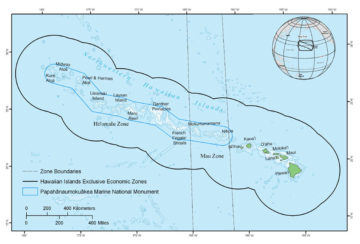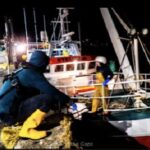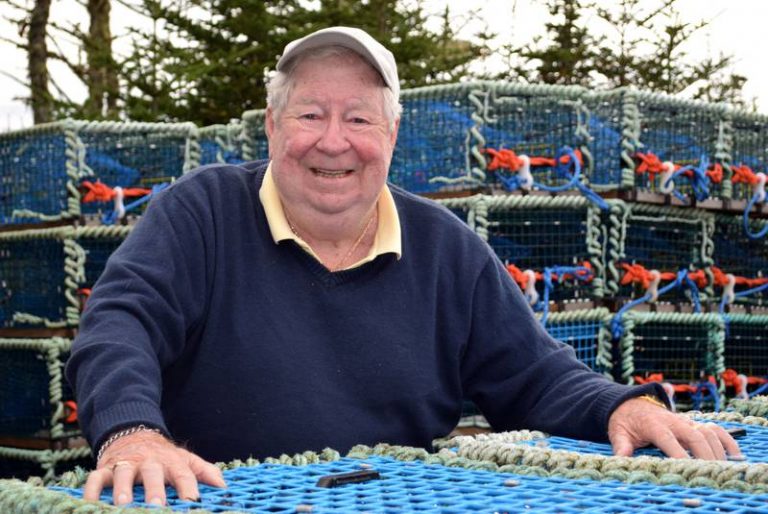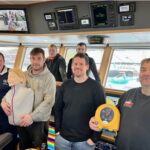Monthly Archives: June 2017
UPDATE – F/V Miss Destinee – Coast Guard, partners continue search for two missing in Marmot Bay, Alaska
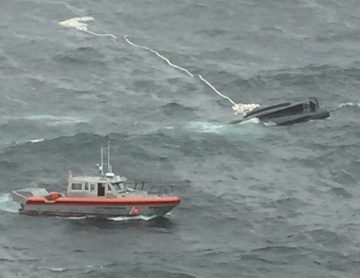 Coast Guard, Alaska Air National Guard and good Samaritans continue to search Friday for one male and one female reported missing from the fishing vessel Miss Destinee that capsized in Marmot Bay. Coast Guard Air Station Kodiak MH-65 Dolphin and MH-60 Jayhawk helicopter crews, a Coast Guard Aids to Navigation Team Kodiak boat crew, the crews of the Coast Guard Cutters Sherman and Chandeleur, nine para-rescuemen from the AK ANG 212th Rescue Squadron and the crew of tug St. Michael searched throughout Thursday night near the location of the Miss Destinee, 23 miles north of Air Station Kodiak.,, A good Samaritan crew rescued two survivors Thursday from the water near the Miss Destinee. click here to read the update 18:32
Coast Guard, Alaska Air National Guard and good Samaritans continue to search Friday for one male and one female reported missing from the fishing vessel Miss Destinee that capsized in Marmot Bay. Coast Guard Air Station Kodiak MH-65 Dolphin and MH-60 Jayhawk helicopter crews, a Coast Guard Aids to Navigation Team Kodiak boat crew, the crews of the Coast Guard Cutters Sherman and Chandeleur, nine para-rescuemen from the AK ANG 212th Rescue Squadron and the crew of tug St. Michael searched throughout Thursday night near the location of the Miss Destinee, 23 miles north of Air Station Kodiak.,, A good Samaritan crew rescued two survivors Thursday from the water near the Miss Destinee. click here to read the update 18:32
Industrializing the Ocean – Floating Wind Plan Could Finally Crack California’s Offshore Market
 A Seattle startup has proposed what could be the world’s largest floating offshore wind farm on a site 33 miles northwest of Morro Bay, anchoring in place around 60 to 100 turbines capable of delivering as much as one gigawatt of electricity into California’s grid.,,, Morro Bay’s roughly 10,000 residents are also divided over the project, and not just because of worries about eyesores on the shoreline. The local commercial-fishing trade group, representing the town’s second-largest industry after tourism, has expressed concerns about losing its territory. click here to read the story 15:09
A Seattle startup has proposed what could be the world’s largest floating offshore wind farm on a site 33 miles northwest of Morro Bay, anchoring in place around 60 to 100 turbines capable of delivering as much as one gigawatt of electricity into California’s grid.,,, Morro Bay’s roughly 10,000 residents are also divided over the project, and not just because of worries about eyesores on the shoreline. The local commercial-fishing trade group, representing the town’s second-largest industry after tourism, has expressed concerns about losing its territory. click here to read the story 15:09

Ballard Locks face millions in upgrades or risk failure
The region’s economy could be at risk, as well as its environment and even highways if one aging chokepoint is not addressed – the Ballard Locks. Needed work on the 100-year-old facility could take between $30-60 million and between 6-10 years to complete. In the meantime, work on items such as the emergency closure system await updates. “If the locks were to fail in an open position, Lake Washington could drain by a pretty dramatic amount and quickly,” said Charles Costanzo with the American Waterways Operators,,, “You have critical infrastructure like the 520 Bridge and the I-90 Bridge; you have a floating bridge that could potentially no longer be floating. That would seriously compromise the integrity of highway infrastructure and be pretty paralyzing to the region.” “If the locks have to close at the opening of a fishing season … it could potentially be a lost season for the fishing industry,” he said. click here to read the story 13:46
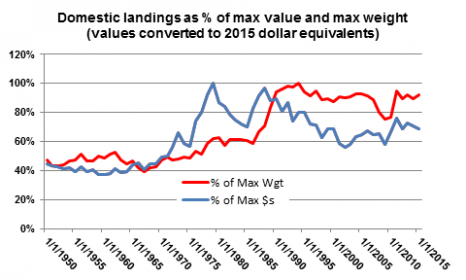
Nils Stolpe, Fishnet USA – So how are we doing? (2017 edition) A Report on our Domestic Commercial Fishing Industry
I occasionally share my impressions of how the domestic commercial fishing industry is doing, using as my primary data source the NMFS online database “Annual Commercial Landing Statistics” (click here). We are fortunate to have these extensive records of commercial landings of fish and shellfish in the United States extending back to 1950 because they allow a fairly comprehensive view of long term industry (and resource) trends. Among the most useful statistics are those dealing with the value and weight of the total landings for each year. Together they give an overview of how the domestic fishing industry is progressing (or regressing) from year to year. Click here to read the report 11:49
Dana Eldridge: Where are the characters?
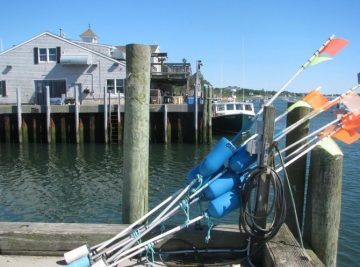 We don’t seem to have as many characters around as I remember as a youngster and that’s too bad. Maybe television has lured them indoors. One example of our long ago character episodes that so enlivened our daily lives follows: During the late 40s and most of the 50s, one of my uncles was a commercial fisherman out of Chatham. His boat, like most of the rest of the fleet, was a Novi, (built in Nova Scotia).,, In those days, fishermen were mostly tub trawlers. A trawl is a long line with hooks every six feet or so. Uncle Bob and his partner Herb would get down to the boat a couple hours before dawn, bait each of the thousands of hooks and set out for one of the fish rich hot spots. After a day of setting the trawl, retrieving the trawl, slatting the fish into the bins, it was time for the hours long slog back to the fish pier. This was the time when the fish got their rudimentary cleaning in preparation for shipment to Boston or New York, where Chatham’s fresh fish always demanded a premium. click here to read the story 09:59
We don’t seem to have as many characters around as I remember as a youngster and that’s too bad. Maybe television has lured them indoors. One example of our long ago character episodes that so enlivened our daily lives follows: During the late 40s and most of the 50s, one of my uncles was a commercial fisherman out of Chatham. His boat, like most of the rest of the fleet, was a Novi, (built in Nova Scotia).,, In those days, fishermen were mostly tub trawlers. A trawl is a long line with hooks every six feet or so. Uncle Bob and his partner Herb would get down to the boat a couple hours before dawn, bait each of the thousands of hooks and set out for one of the fish rich hot spots. After a day of setting the trawl, retrieving the trawl, slatting the fish into the bins, it was time for the hours long slog back to the fish pier. This was the time when the fish got their rudimentary cleaning in preparation for shipment to Boston or New York, where Chatham’s fresh fish always demanded a premium. click here to read the story 09:59
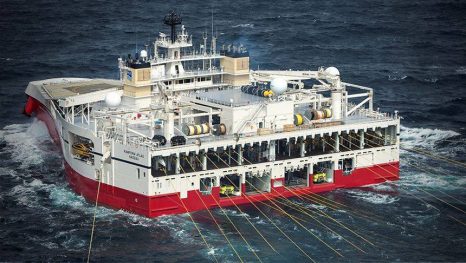
Rutherford, others sign letter opposing Atlantic coast seismic testing for oil exploration
The same day that President Donald Trump touted new energy policies during a speech at the U.S. Department of Energy that he said were part of a “golden era of American energy,” Rep. John Rutherford’s office released a letter signed by him more and than 100 other members of Congress that voiced opposition to the use of a controversial oil and gas exploration technique off the Atlantic Coast. “We are writing in strong opposition to your recent secretarial order to move forward with offshore oil and gas exploration in the Atlantic Ocean,” the letter, signed by members of both parties and addressed to Department of Interior Secretary Ryan Zinke, began. “Offshore oil and gas exploration, the first step of which is seismic air gun testing, puts at risk coastal economies based on fishing, tourism, and recreation,” it said before asking Zinke not to issue any permits for the surveys. click here to read the story 09:10
FISH-NL calls on C-NLOPB to suspend seismic work in light of potential impact on basis of marine food chain
 The Federation of Independent Sea Harvesters of Newfoundland and Labrador (FISH-NL) has requested that the Canada-Newfoundland and Labrador Offshore Petroleum Board (C-NLOPB) immediately suspend seismic work off Newfoundland and Labrador in light of a new study that found the intense acoustic signals may damage critical elements of the marine food chain. “With most commercial fish stocks at or near critical levels our first priority must be the health of our renewable marine resources,” says Ryan Cleary, President of FISH-NL, who made the request Thursday in a letter to Scott Tessier, chair and executive officer of the C-NLOPB. “The potential impact of seismic testing on the marine environment — combined with a potential conflict of interest in which the best interests of inshore harvesters may not be represented — should compel the C-NLOPB to act,” Cleary wrote in the letter. click here to read the press release 08:59
The Federation of Independent Sea Harvesters of Newfoundland and Labrador (FISH-NL) has requested that the Canada-Newfoundland and Labrador Offshore Petroleum Board (C-NLOPB) immediately suspend seismic work off Newfoundland and Labrador in light of a new study that found the intense acoustic signals may damage critical elements of the marine food chain. “With most commercial fish stocks at or near critical levels our first priority must be the health of our renewable marine resources,” says Ryan Cleary, President of FISH-NL, who made the request Thursday in a letter to Scott Tessier, chair and executive officer of the C-NLOPB. “The potential impact of seismic testing on the marine environment — combined with a potential conflict of interest in which the best interests of inshore harvesters may not be represented — should compel the C-NLOPB to act,” Cleary wrote in the letter. click here to read the press release 08:59
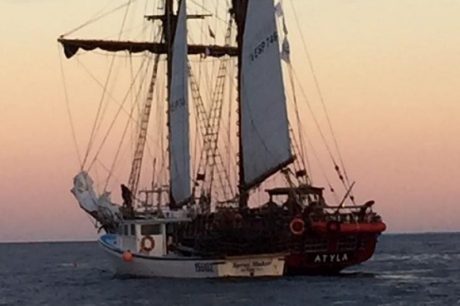
P.E.I. fishermen surprise tall ship crew by giving them lobster
A Spanish tall ship visiting P.E.I. drifted into a seafood surprise off Beach Point when it received some fresh lobster from fisherman Frank MacNeill and his crew. It was just before sunset on Tuesday, June 27, and the fishermen had finished hauling up the lobster traps aboard MacNeill’s boat, Spray Maker, when they realized the tall ship was close by. “She wasn’t far from us at all,” said MacNeill. “I just circled up and I asked them if they’d got lobsters off any of the (other lobster fishermen) and they said no.” There were four or five other lobster boats in the same waters that day, said MacNeill, some of which had already approached the tall ship. “I went back and seen what was in the trays — there was probably 35 or more lobsters — and I said to the boys, ‘we mays as well give ‘em all.’ ” click here to read the story 08:24
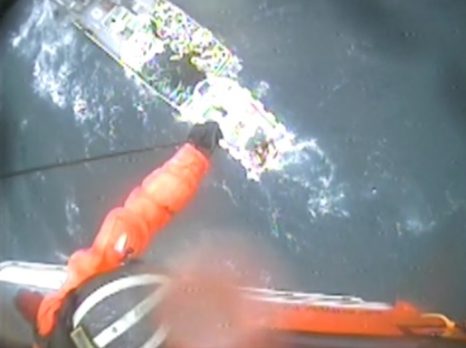
Coast Guard, good Samaritan vessel search for 2 missing Fishermen in Marmot Bay, Alaska
Coast Guard crews and a good Samaritan vessel crew are searching Thursday for one male and one female reported missing from the fishing vessel Miss Destinee that capsized in Marmot Bay. Coast Guard Air Station Kodiak MH-65 Dolphin and MH-60 Jayhawk helicopter crews, a Coast Guard Aids to Navigation Team Kodiak boatcrew and the crew of the good Samaritan vessel are searching near the location of the Miss Destinee, 23 miles north of Air Station Kodiak. The good Samaritan crew recovered two people aboard the Miss Destinee. One of the two was the master of the Miss Destinee, who confirmed there were two other people missing after a large wave capsized the vessel. Watchstanders at Coast Guard Sector Anchorage received a mayday transmission over VHF-FM channel 16 from the good Samaritan at approximately 7:30 a.m., Thursday, to coordinate a search for the missing boaters. The good Samaritan crew reported they recovered the master and his crewman from the Miss Destinee click here to read press release View hoist video 19:45
Shrimp-net violation leads to drug bust
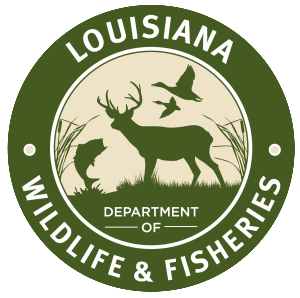 A routine vessel inspection turned into an unusual bust for Louisiana Department of Wildlife and Fisheries agents Tuesday, the agency reported. Agents working state offshore waters under a joint enforcement agreement with the federal government made contact with a 42-foot shrimp boat captained by Anouda Lirette, 39, of Bayou Dularge. While inspecting the boat, agents noticed the skimmer nets were oversized, and also saw dead seagulls on the boat’s deck, the department reported. Upon further investigation, agents say they found a .22-caliber rifle, marijuana, crystal methamphetamine and drug paraphernalia on board.,,, click here to read the story 17:49
A routine vessel inspection turned into an unusual bust for Louisiana Department of Wildlife and Fisheries agents Tuesday, the agency reported. Agents working state offshore waters under a joint enforcement agreement with the federal government made contact with a 42-foot shrimp boat captained by Anouda Lirette, 39, of Bayou Dularge. While inspecting the boat, agents noticed the skimmer nets were oversized, and also saw dead seagulls on the boat’s deck, the department reported. Upon further investigation, agents say they found a .22-caliber rifle, marijuana, crystal methamphetamine and drug paraphernalia on board.,,, click here to read the story 17:49
Massachusetts Appeals Court Upholds Applicability of WPA to Commercial Fishing Techniques Using Hydraulic Dredging Methods
 The Massachusetts Appeals Court upheld the applicability of the state’s Wetlands Protection Act (WPA) to commercial fishing activities using hydraulic dredging methods on land under ocean and nearshore areas, clarifying municipal authority to impose additional requirements on activities in wetlands in relation to shell fishing. However, in the same opinion, the Court concluded that a town bylaw prohibiting hydraulic dredging in nearshore areas without a permit is preempted by state law as applied to sea clam and quahog harvesting. In Aqua King Fishery, the Conservation Commission of Provincetown alleged that Aqua King Fishery, LLC violated both Provincetown’s Wetlands Bylaw and the WPA when it failed to obtain the Commission’s approval for the use of hydraulic dredge fishing gear for commercial sea clam fishing near Provincetown’s shore. click here to read the story 16:22
The Massachusetts Appeals Court upheld the applicability of the state’s Wetlands Protection Act (WPA) to commercial fishing activities using hydraulic dredging methods on land under ocean and nearshore areas, clarifying municipal authority to impose additional requirements on activities in wetlands in relation to shell fishing. However, in the same opinion, the Court concluded that a town bylaw prohibiting hydraulic dredging in nearshore areas without a permit is preempted by state law as applied to sea clam and quahog harvesting. In Aqua King Fishery, the Conservation Commission of Provincetown alleged that Aqua King Fishery, LLC violated both Provincetown’s Wetlands Bylaw and the WPA when it failed to obtain the Commission’s approval for the use of hydraulic dredge fishing gear for commercial sea clam fishing near Provincetown’s shore. click here to read the story 16:22
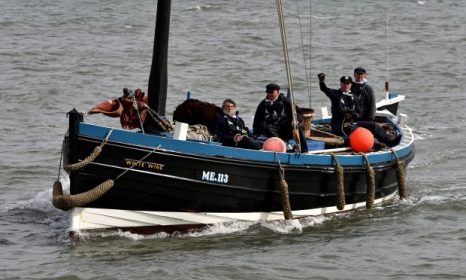
Historic Mearns fishing vessel returned home after 75 years
For decades the baldie drifter White Wing set off on daily journeys from the small harbour, creeling and laying mussel-baited lines in pursuit of east coast haddock. The 33-foot boat, registered ME 113, served Gourdon well before going on to fill a small screen role in a television documentary about Scotland’s fishing industry. It was subsequently gifted to the Scottish Fisheries Museum at Anstruther, and as part of a weekend tour of the north east during which it visited both Gardenstown – where she was built in 1917 – and the Portsoy boat festival, before the evocative sailing into Gourdon harbour. The clinker-built boat was a smaller version of the Fifie herring drifters common along the country’s east coast. click here to read the story, see more images 13:16
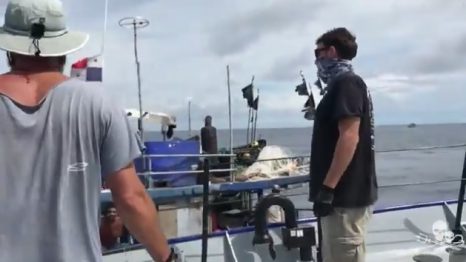
Sea Shepherd Vessel Rammed By Fishing Boat in Panama
A Sea Shepherd vessel suffered minor damage on Wednesday when it was rammed by a fishing boat while patrolling in the Coiba marine reserve, off the Pacific coast of Panama. While monitoring and documenting fishing boats engaged in long-line fishing inside the reserve, the anti-poaching group’s cutter, the M/V John Paul DeJoria, was surrounded by five fishing boats at around 3pm. According to the crew, the fishermen threatened the non-profit marine protection group by throwing items at John Paul DeJoria, while gesturing and shouting aggressively. Then, the 110-foot Island class patrol boat was rammed by one of the five boats and suffered minor damage. video, read the story here 12:55
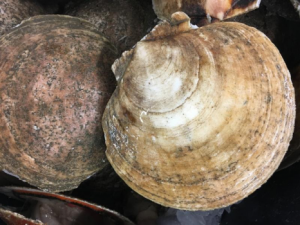
NMFS Proposes State Water Exemptions for Scallop Fisheries in Maine and Massachusetts
The National Marine Fisheries Service is seeking comment on a proposed rule that would revise the State Waters Exemption Program under the Atlantic Sea Scallop Fishery Management Plan. Under this proposed rule, vessels holding both a Massachusetts state scallop permit and either a Limited Access General Category (LAGC) Individual Fishing Quota (IFQ) or LAGC Northern Gulf of Maine (NGOM) Federal scallop permit could continue to fish in state waters once the Federal Total Allowable Catch (TAC) for the NGOM Management Area has been fully harvested. This action would also modify the State Waters Exemption for Maine, which already has this exemption for vessels holding state scallop permits and LAGC NGOM permits, to include vessels that have both a state scallop permit and an LAGC IFQ permit. Read the notice in the Federal Register 12:17
South Carolina restricts flounder fishing in an effort to help the species recover
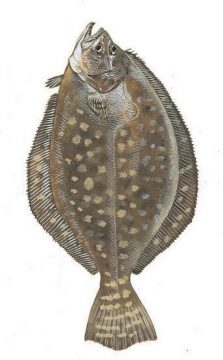 Anyone fishing for flounder from a dock or pier can keep only 10 fish per day, down from a limit of 15 flounder per day, according to restrictions approved this past spring by the Legislature. Fishing boats can keep no more than 20 flounder per day, regardless of how many anglers are in the vessel.The previous boat limit was 30 flounder. The rules apply to recreational anglers as well commercial fishermen who use hooks and lines, according to the Department of Natural Resources. Violating the bag limit carries fines of $25 to $500 and possible jail time. In a news release Wednesday, DNR biologists said the tighter fishing limits mean 30 percent fewer fish will be landed in the next two years, giving flounder a chance to come back. click here to read the story 11:47
Anyone fishing for flounder from a dock or pier can keep only 10 fish per day, down from a limit of 15 flounder per day, according to restrictions approved this past spring by the Legislature. Fishing boats can keep no more than 20 flounder per day, regardless of how many anglers are in the vessel.The previous boat limit was 30 flounder. The rules apply to recreational anglers as well commercial fishermen who use hooks and lines, according to the Department of Natural Resources. Violating the bag limit carries fines of $25 to $500 and possible jail time. In a news release Wednesday, DNR biologists said the tighter fishing limits mean 30 percent fewer fish will be landed in the next two years, giving flounder a chance to come back. click here to read the story 11:47

Drones and high-tech cameras used to catch illegal crabbing activity in New South Wales
More than 460 crabbing offences have been detected by the NSW Department of Primary Industries during the six-month Operation Portunus. The 60 officers involved used drones and long-range surveillance cameras to locate illegal traps and crab fishing activity up and down the east coast of the state. Director of fisheries compliance Patrick Tully said the statewide operation had been aimed at reducing illegal crab trapping. “Crabs are very valuable. They’re easy to catch but there are rules,” he said. “Anything that we detect that’s outside the rules we treat as illegal fishing, and we hope people understand that in those situations you can face some pretty tough consequences.” click here to read the story 09:23
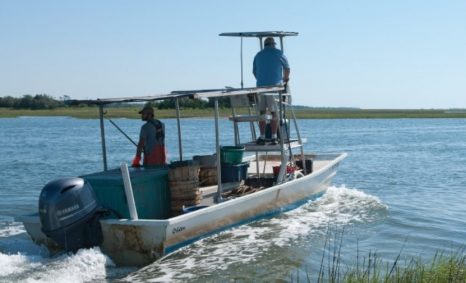
A Fisherman’s Life – Sammy Corbett
When you live and breathe fishing, it’s important to keep an ample supply of bait on hand. Time spent running to the store is time that could be spent on the water. Sammy Corbett found a simple fix to the problem. “I remember he used to live on Pelican Drive in Wrightsville Beach,” says childhood friend Robbie Wolf. “He drained his parents’ swimming pool and pumped salt water in so he could store live bait in it.” When you live and breathe fishing, you don’t let a little spell of bad weather stop you. “Me and him went trout fishing one day and we were about to freeze,” Wolf says. “He lit cans of Sterno and made a fire in the middle of the boat.” Those two stories sum up Sammy Corbett. He’s a fisherman. Period. He’s on the water every day, unless he has to go to a meeting. His expertise — and his reputation — led to an appointment three years ago as chairman of the North Carolina Marine Fisheries Commission. click here to read the story 08:58

This year, a welcome switch on bait supply for Maine lobstermen
Bait freezers along the coast are full of herring and pogies, and even alewives, which means that bait is not only available, it is also much less expensive than last year when herring cost as much as 60 cents a pound, said Pat Keliher, commissioner of the state Department of Marine Resources. This year the lobstermen’s go-to bait costs about half as much. That’s still not a great price, Keliher said. Herring fetched about 18 cents a pound at the start of the 2015 lobstering season. “I won’t say we’re in great shape, but we are in a heck of a lot better shape than we were last year,” Keliher said. He attributed the strong start to basic supply-and-demand economics. click here to read the story 08:18
Lawsuit Launched to End Whale, Sea Turtle Entanglements in California Dungeness Crab Gear
 The Center for Biological Diversity today filed a formal notice of intent to sue California’s state wildlife agency for failing to prevent commercial Dungeness crab gear from entangling, injuring and killing threatened and endangered humpback whales, blue whales and sea turtles. California’s Department of Fish and Wildlife authorizes and manages operation of the fishery, which last year entangled at least 21 endangered or threatened whales, contributing to a third straight record-breaking year for entanglements along the U.S. West Coast. An endangered leatherback sea turtle was also caught in commercial Dungeness crab gear in 2016. Today’s notice letter notes that the Department’s failure to protect imperiled whales and sea turtles from entanglements in crab gear violates the federal Endangered Species Act. click here to read press release 20:47
The Center for Biological Diversity today filed a formal notice of intent to sue California’s state wildlife agency for failing to prevent commercial Dungeness crab gear from entangling, injuring and killing threatened and endangered humpback whales, blue whales and sea turtles. California’s Department of Fish and Wildlife authorizes and manages operation of the fishery, which last year entangled at least 21 endangered or threatened whales, contributing to a third straight record-breaking year for entanglements along the U.S. West Coast. An endangered leatherback sea turtle was also caught in commercial Dungeness crab gear in 2016. Today’s notice letter notes that the Department’s failure to protect imperiled whales and sea turtles from entanglements in crab gear violates the federal Endangered Species Act. click here to read press release 20:47
Owner of Giant 20-Pound Lobster ‘Beyond Ticked Off’ Over TSA’s Handling of Crustacean
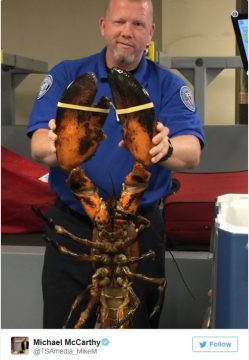 The owner of the 20-pound lobster that was photographed by TSA agents inside Boston’s Logan Airport and posted to social media is furious about how the agency handled the massive sea creature. Chris Stracuzza of Savannah, Ga., told Inside Edition that he is “beyond ticked off” that agents were able to open his luggage in the first place. They shouldn’t be able to go through people’s luggage and post their photos online,” he added. The huge lobster was posted on social media Monday by TSA spokesman Michael McCarthy, the day after it was photographed inside Logan Airport. And Stracuzza isn’t the only one unhappy with the way the lobster was handled. Video, click here to read the story 17:38
The owner of the 20-pound lobster that was photographed by TSA agents inside Boston’s Logan Airport and posted to social media is furious about how the agency handled the massive sea creature. Chris Stracuzza of Savannah, Ga., told Inside Edition that he is “beyond ticked off” that agents were able to open his luggage in the first place. They shouldn’t be able to go through people’s luggage and post their photos online,” he added. The huge lobster was posted on social media Monday by TSA spokesman Michael McCarthy, the day after it was photographed inside Logan Airport. And Stracuzza isn’t the only one unhappy with the way the lobster was handled. Video, click here to read the story 17:38
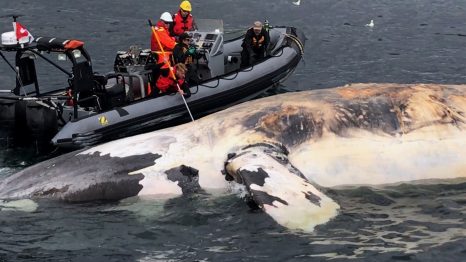
Carcass of right whale being towed to P.E.I. to determine cause of death
The Canadian Coast Guard and Fisheries and Oceans Canada were expected to beach a dead right whale on a Prince Edward Island shore Wednesday in a bid to learn what killed at least six of the endangered mammals in recent weeks. Tonya Wimmer of the Marine Animal Response Society said the carcass was being towed to shore at Norway, P.E.I., with the intention of conducting a necropsy on Thursday. “For the coast guard and Fisheries and Oceans … it is a very slow process to ensure the safety of the people on the boats and also make sure they don’t lose the animal midway coming in. Some of these animals are coming from quite a ways away,” Wimmer said. click here to read the story 15:22
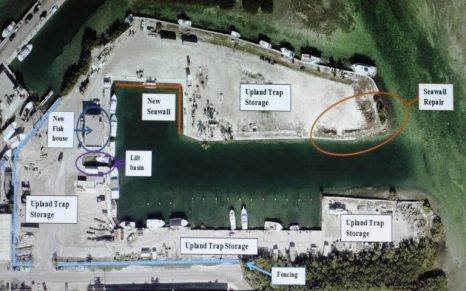
Is the Gulf Seafood Fish House deal close?
What was once the Gulf Seafood fish house on Stock Island may become Gulf Seafood again in the near future. “We think it’s going to happen, that it will be preserved in perpetuity for commercial fishing,” said lobster fisherman Simon Stafford. “That’s the real goal. It would be something unique to the Lower Keys.” Monroe County staffers have been working with the Florida Communities Trust to acquire the eight-acre property at 6011 Peninsular Ave. for several years. If the purchase goes through, the concept is to keep the property dedicated as a publicly owned “working waterfront” with a focus on commercial fishing. “We can say it’s moving forward in a positive way,” Lisa Tennyson, county director of legislative affairs and grants acquisition, said. “We can’t say much beyond that.” click here to read the story 14:35
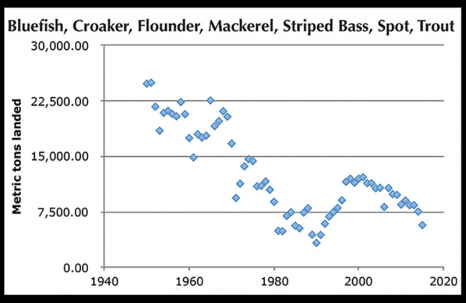
Chesapeake Bay fishery to keep deteriorating unless nutrients from land are addressed
The March Bay Journal 2017 commentary, Don’t let menhaden become a case of could have, should have, would have, laments the decline in Bay menhaden populations and blames the reduced number of predatory “sport” fish on Omega Protein’s harvest (click here). The Atlantic States Marine fisheries Commission is quite clear this year that “Atlantic menhaden are neither overfished nor experiencing overfishing” (click here). In Maryland, juvenile menhaden are sampled annually through the Estuarine Juvenile Finfish Survey. The index of juvenile menhaden has been low since 1992, and “environmental conditions seem to be a major factor driving recruitment.” (click here). Something other than overfishing must contribute to, or even be responsible for, reduced Bay menhaden populations. I contend that the primary cause of depleted finfish stocks, including bottom-feeding fish like croaker that do not eat menhaden, and the menhaden themselves, is poor water quality, not overfishing. click here to read the story 12:17
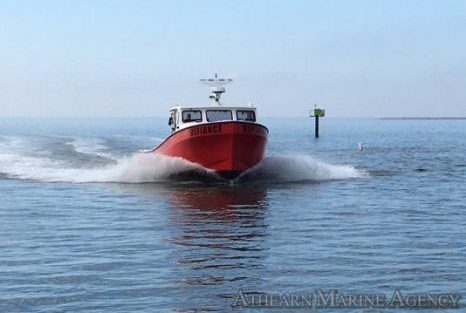
Athearn Marine Agency Boat of the Week: 45′ Solid Fiberglass Lobster/Dive boat, 750HP John Deere
Specifications, information and 12 photos click here Vessel was built new 2016 by Long Beach Boat Building Ltd in Nova Scotia and was finished by Dana’s Boat Shop in Westport, ME. To see all the boats in this series, Click here 12:04
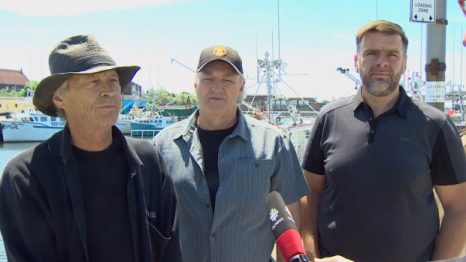
DFO plan for at-sea observers met with skepticism by lobster fishermen
A federal government proposal to introduce mandatory at-sea observers on board the southwest Nova Scotia lobster fleet is getting a cold shoulder from representatives of three fisheries groups.
The Department of Fisheries and Oceans wants observers to monitor bycatch of cod and cusk caught inadvertently in lobster traps. Bernie Berry of the Coldwater Lobster Association said the plan would require all fishermen to notify the government every time they plan to leave port — a process known as hailing out. Some would be randomly selected to have an observer from an existing monitoring company meet them at the dock prior to sailing. click here to read the story 11:37
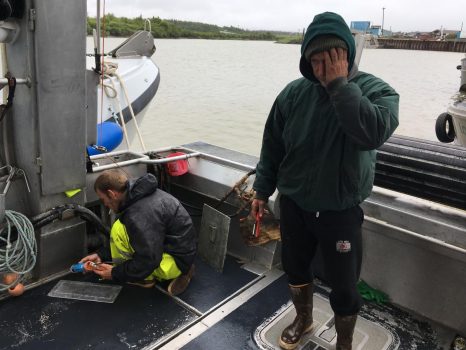
The Nushagak run surges early, and maybe big too?
Bristol Bay’s westside district posts a million sockeye catch Monday, and both the Wood and Nushagak Rivers have met their escapement goals. The red run is off the charts, but the kings are lagging big time.,,, On Sunday June 25, the fleet caught more than 400,000 sockeye, and Monday’s tally was an incredible 1,050,000. “Since I’ve been here, the single day harvest has never exceed a million fish,” Sands said Tuesday morning after the counts came in. “I talked to Jeff Skrade [his predecessor], and he recalls once in 1981 breaking the million fish harvest, and I don’t know if that was sockeye or just fish, but, we’re pretty excited down here to see such a big harvest.” click here for audio, read the story 11:09
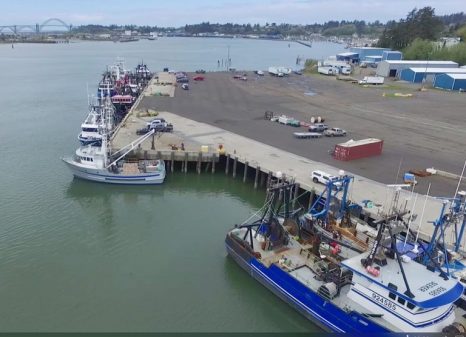
Port of Newport re-assessing access to new International Terminal
Three Newport Port Commissioners got an earful of opinions from local mid-water commercial fishermen Tuesday night down on the Bayfront. Over 80 fishermen showed up at the yachat club to tell the Newport Port Commission that they feel left out of the port’s plans in that the port seems to be focusing on bringing back heavy shipping to Newport at the expense of the Newport fishing fleet, the largest in Oregon and which is a major contributor to the Newport area economy. Fishermen reminded the commission that a promise was made a number of months ago that as the port began negotiations with the shipping industry, scheduling access to the International Terminal would be formulated to serve both the shipping industry and the fishing fleet. click here to read the story 08:49
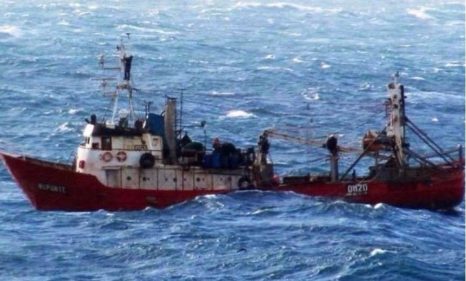
Search Effort Continues for Missing Argentine Fishermen
An Argentine Navy salvage vessel is working with a remotely operated vehicle to inspect the hull of the shrimp trawler Repunte, which sank in a storm about 35 nm off of the port of Rawson, Argentina on June 17. Seven men remain missing ten days after the vessel went down, and the SAR effort continues. The two known survivors were identified as Julio Guaymas, 39, who was lifted from the water by a SAR helicopter; and Lucas Trillo, 35, who was rescued by a good samaritan fishing vessel. Newspaper Los Andes reports that dozens of relatives and friends of the missing organized a protest march through the port of Mar Del Plata to demand answers from the shipowner and from the maritime authorities. click here to read the story 08:29
Maritime mystery in Connecticut! How did huge Pacific Dungeoness crabs get to Norwalk waters?
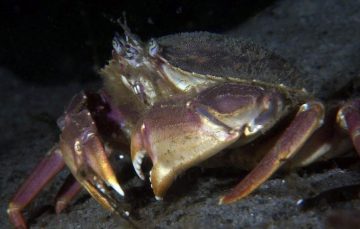 It’s not easy to stump the marine experts at the Maritime Aquarium. But that’s exactly what happened after fishermen from Copps Island Oysters hauled in four unusual, clawed critters last week on the south side of the Norwalk Islands. Dick Harris, marine specialist for Copps Island, said the fishermen were unsure of what the creatures were — and what to do with them — so they tossed three back and one brought to the aquarium. Aquarists identified the 2.5-pound crustacean as a male dungeness crab, native to the icy waters of the Pacific. “We’re doing our own research on this right now,” said Sandi Schaefer-Padgett, senior aquarist at the aquarium. “It’s not normal. We don’t often get things that no one’s seen before.” click here to read the story 07:36
It’s not easy to stump the marine experts at the Maritime Aquarium. But that’s exactly what happened after fishermen from Copps Island Oysters hauled in four unusual, clawed critters last week on the south side of the Norwalk Islands. Dick Harris, marine specialist for Copps Island, said the fishermen were unsure of what the creatures were — and what to do with them — so they tossed three back and one brought to the aquarium. Aquarists identified the 2.5-pound crustacean as a male dungeness crab, native to the icy waters of the Pacific. “We’re doing our own research on this right now,” said Sandi Schaefer-Padgett, senior aquarist at the aquarium. “It’s not normal. We don’t often get things that no one’s seen before.” click here to read the story 07:36












